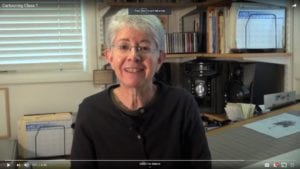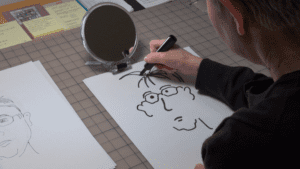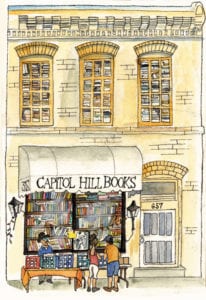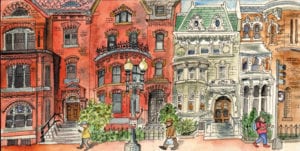How does one teach a creative discipline online? Local artist Leila Cabib discovered her own response to this challenge with help from her sister, local filmmaker Cintia Cabib. Together the pair created a series of instructional videos to pair with her new Zoom classroom. Though Leila has had many adventures in her life, her pivot to virtual teaching may be one of her most memorable journeys yet!

Born in Buenos Aires, Argentina, Leila Cabib immigrated to the United States with her family at the age of seven. After graduating from Bard College in 1982 she worked as a freelance cartoonist and illustrator and soon began teaching both cartooning (1991) and animation (2001) professionally. In July 2019 Leila received a Wheaton Cultural Project Grant and an Arts Residencies in Schools Grant from the Arts and Humanities Council of Montgomery County to teach cartooning and animation to kids and senior citizens in Montgomery County schools and public libraries throughout 2020. But when the coronavirus hit and the schools and libraries closed, Leila needed to explore alternative ways to offer her classes and workshops online.
After consulting with other teaching artists, Leila decided to present the lessons through a series of instructional videos followed by live Zoom sessions. She expected her students to arrive prepared from the instructional videos to her virtual classroom, allowing her to reinforce the information through live drawing demonstrations on Zoom’s whiteboard. However, this required the veteran teaching artist to acquire some new skills and utilize new technology.
To modify her normal teaching approach, Leila purchased a tablet and stylus that connected to her computer and allowed her to sketch online. Whatever Leila drew on her tablet would display through the virtual whiteboard for her class to follow. She also purchased a document camera to demonstrate proper use of various tools. Let’s pause for a moment…What is a document camera? And how does it work? Much like old-school overhead projectors, a document camera captures real-time images of documents or 3-D objects then magnifies the image and projects it onto the screen for online audiences to see. The camera’s ability to integrate physical objects into a lesson is a feature Leila found incredibly helpful when demonstrating how to use different tools.

Producing this kind of virtual content was quite a learning experience for Leila. This was her first-time offering classes online, using Zoom, and creating instructional videos. She had so much to learn! Luckily, her sister Cintia, a documentary filmmaker, helped her film the on-camera introductions, record voice-over scripts, and edit the videos along with images she assembled to illustrate the lessons. The most interesting part of this learning process for Leila was discovering how many drawings she had to create in order to illustrate the instructions stated in the voice-over.
Even with the new technology and teaching style, virtual instruction has many limitations: the inability to walk around the classroom, observe participants’ artwork, and engage with them individually. Not being in the same space could make the classes feel formal and less appealing to participate in; however, despite these difficulties, Leila found many participants were eager to share their work on camera and engage with one another as best they could. For instance, during one of the classes, a student was having trouble drawing a turban so another student offered to wrap a towel around her head and model it for her to draw. Memorable moments such as this occur naturally during in-person sessions and Leila found it most gratifying to see the students engaging in the class and supporting one another in this virtual space. Seeing people connect with each other during a period of isolation was truly heartening.

Teaching online provided numerous benefits for Leila and her students. She learned about new technology, gained new skills, and provided a safe space for kids and seniors to connect with one another virtually. She also maintained relationships with many of her in-person students who registered for her online courses during quarantine. To her great surprise, the graphic novel creation class she offered in partnership with Montgomery County Public Libraries filled in two days with a waiting list. Her cartooning class for seniors also filled, demonstrating just how critical the arts are for the human soul, mind, and spirit. Everyone enjoyed creating and sharing their artwork with one another despite the limitations of a virtual platform and Zoom fatigue.
Leila’s successful creative pivot opened new possibilities to teach beyond her geographical area and provide instruction for homebound students and seniors. Only time will tell if she will continue exploring online teaching as she returns to in-person instruction. As the DMV region opens back up, Leila looks forward to taking the Metro downtown and sketching the historic buildings in various D.C. neighborhoods. She loves the character and interesting details of 19th century architecture in addition to the intense focus she feels when trying to capture these buildings on paper. For her, it is a bit of an adventure to explore D.C.’s neighborhoods and learn about the city’s history and its residents through its architectural design.

Published works: Leila’s illustrations have been published in magazines, books and newspapers, as well as an environmental museum in Vermont. Her clients include The Wall Street Journal, The Washington Post, Time-Life Books, Gannett newspapers and many other publications and organizations. View her work here: http://www.leilacabib.com/
Visit her Artist Profile on CultureSpotMC.com: https://www.culturespotmc.com/artist/leila-cabib/
